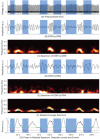Screening for Obstructive Sleep Apnea in Commercial Drivers Using EKG-Derived Respiratory Power Index
- PMID: 30621825
- PMCID: PMC6329542
- DOI: 10.5664/jcsm.7562
Screening for Obstructive Sleep Apnea in Commercial Drivers Using EKG-Derived Respiratory Power Index
Abstract
Study objectives: Obstructive sleep apnea (OSA) is common in commercial motor vehicle operators (CMVOs); however, polysomnography (PSG), the gold-standard diagnostic test, is expensive and inconvenient for screening. OSA is associated with changes in heart rate and voltage on electrocardiography (EKG). We evaluated the utility of EKG parameters in identifying CMVOs at greater risk for sleepiness-related crashes (apnea-hypopnea index [AHI] ≥ 30 events/h).
Methods: In this prospective study of CMVOs, we performed EKGs with concurrent PSG, and calculated the respiratory power index (RPI) on EKG, a surrogate for AHI calculated from PSG. We evaluated the utility of two-stage predictive models using simple clinical measures (age, body mass index [BMI], neck circumference, Epworth Sleepiness Scale score, and the Multi-Variable Apnea Prediction [MVAP] score) in the first stage, followed by RPI in a subset as the second-stage. We assessed area under the receiver operating characteristic curve (AUC), sensitivity, and negative posttest probability (NPTP) for this two-stage approach and for RPI alone.
Results: The best-performing model used the MVAP, which combines BMI, age, and sex with three OSA symptoms, in the first stage, followed by RPI in the second. The model yielded an estimated (95% confidence interval) AUC of 0.883 (0.767-0.924), sensitivity of 0.917 (0.706-0.962), and NPTP of 0.034 (0.015-0.133). Predictive characteristics were similar using a model with only BMI as the first-stage screen.
Conclusions: A two-stage model that combines BMI or the MVAP score in the first stage, with EKG in the second, had robust discriminatory power to identify severe OSA in CMVOs.
Keywords: EKG; OSA; commercial motor vehicle drivers; electrocardiography; obstructive sleep apnea; occupational driving; respiratory power index; screening; surrogate measure for apnea hypopnea index; truck drivers.
© 2019 American Academy of Sleep Medicine.
Figures

References
-
- Philip P. Sleepiness of occupational drivers. Ind Health. 2005;43(1):30–33. - PubMed
-
- Radun I, Summala H. Sleep-related fatal vehicle accidents: characteristics of decisions made by multidisciplinary investigation teams. Sleep. 2004;27(2):224–227. - PubMed
-
- Akerstedt T. Consensus statement: fatigue and accidents in transport operations. J Sleep Res. 2000;9(4):395. - PubMed
-
- Howard ME, Desai AV, Grunstein RR, et al. Sleepiness, sleep-disordered breathing, and accident risk factors in commercial vehicle drivers. Am J Respir Crit Care Med. 2004;170(9):1014–1021. - PubMed
Publication types
MeSH terms
Grants and funding
LinkOut - more resources
Full Text Sources

